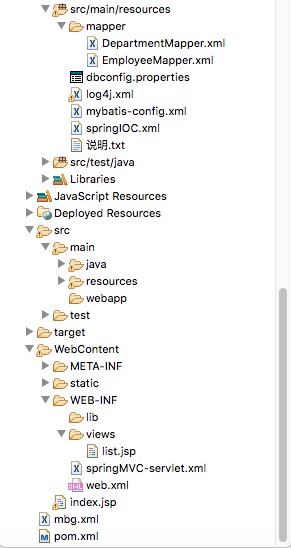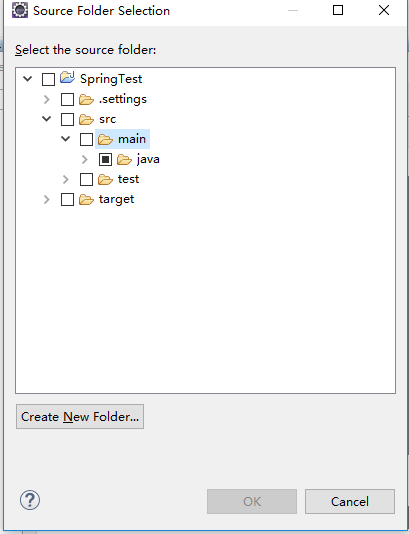有时配置文件会报错,主要是网络读取不到文件的原因。可以先clean project ,然后再重新update project。报错举例:
- schema_reference.4: Failed to read schema document 'http://www.springframework.org/schema/tx/spring- tx-4.3.xsd', because 1) could not find the document; 2) the document could not be read; 3) the root element of the document is not <xsd:schema>.
一、配置Web.xml
<?xml version="1.0" encoding="UTF-8"?>
<web-app xmlns:xsi="http://www.w3.org/2001/XMLSchema-instance"
xmlns="http://java.sun.com/xml/ns/javaee"
xsi:schemaLocation="http://java.sun.com/xml/ns/javaee http://java.sun.com/xml/ns/javaee/web-app_2_5.xsd"
id="WebApp_ID" version="2.5">
<!--1、启动Spring的容器 -->
<!-- needed for ContextLoaderListener -->
<context-param>
<param-name>contextConfigLocation</param-name>
<param-value>classpath:springIOC.xml</param-value>
</context-param>
<!-- Bootstraps the root web application context before servlet initialization -->
<listener>
<listener-class>org.springframework.web.context.ContextLoaderListener</listener-class>
</listener>
<!--2、springmvc的前端控制器,拦截所有请求 -->
<!-- The front controller of this Spring Web application, responsible for handling all application requests -->
<servlet>
<servlet-name>springMVC</servlet-name>
<servlet-class>org.springframework.web.servlet.DispatcherServlet</servlet-class>
<load-on-startup>1</load-on-startup>
</servlet>
<!-- Map all requests to the DispatcherServlet for handling -->
<servlet-mapping>
<servlet-name>springMVC</servlet-name>
<url-pattern>/</url-pattern>
</servlet-mapping>
<!-- 3、字符编码过滤器,一定要放在所有过滤器之前 -->
<filter>
<filter-name>CharacterEncodingFilter</filter-name>
<filter-class>org.springframework.web.filter.CharacterEncodingFilter</filter-class>
<init-param>
<param-name>encoding</param-name>
<param-value>utf-8</param-value>
</init-param>
<init-param>
<param-name>forceRequestEncoding</param-name>
<param-value>true</param-value>
</init-param>
<init-param>
<param-name>forceResponseEncoding</param-name>
<param-value>true</param-value>
</init-param>
</filter>
<filter-mapping>
<filter-name>CharacterEncodingFilter</filter-name>
<url-pattern>/*</url-pattern>
</filter-mapping>
<!-- 4、使用Rest风格的URI,将页面普通的post请求转为指定的delete或者put请求 -->
<filter>
<filter-name>HiddenHttpMethodFilter</filter-name>
<filter-class>org.springframework.web.filter.HiddenHttpMethodFilter</filter-class>
</filter>
<filter-mapping>
<filter-name>HiddenHttpMethodFilter</filter-name>
<url-pattern>/*</url-pattern>
</filter-mapping>
<!-- 5、直接支持put请求的拦截器,即在put请求时将请求体数据封装成map,并让springmvc能够通过request.getParameter(属性名) 来获取数据 -->
<filter>
<filter-name>HttpPutFormContentFilter</filter-name>
<filter-class>org.springframework.web.filter.HttpPutFormContentFilter</filter-class>
</filter>
<filter-mapping>
<filter-name>HttpPutFormContentFilter</filter-name>
<url-pattern>/*</url-pattern>
</filter-mapping>
</web-app>
二、配置springmvc
与web.xml目录同级下创建,springMVC-servlet.xml ,这是根据web.xml中配置的springMVC 得来的。
<?xml version="1.0" encoding="UTF-8"?>
<beans xmlns="http://www.springframework.org/schema/beans"
xmlns:xsi="http://www.w3.org/2001/XMLSchema-instance"
xmlns:context="http://www.springframework.org/schema/context"
xmlns:mvc="http://www.springframework.org/schema/mvc"
xsi:schemaLocation="http://www.springframework.org/schema/mvc http://www.springframework.org/schema/mvc/spring-mvc-4.3.xsd
http://www.springframework.org/schema/beans http://www.springframework.org/schema/beans/spring-beans-3.2.xsd
http://www.springframework.org/schema/context http://www.springframework.org/schema/context/spring-context-4.3.xsd">
<!--SpringMVC的配置文件,包含网站跳转逻辑的控制,配置 -->
<context:component-scan base-package="com.ssm.crud" use-default-filters="false">
<!--只扫描控制器。 -->
<context:include-filter type="annotation" expression="org.springframework.stereotype.Controller"/>
</context:component-scan>
<!--配置视图解析器,方便页面返回 -->
<bean class="org.springframework.web.servlet.view.InternalResourceViewResolver">
<property name="prefix" value="/WEB-INF/views/"></property>
<property name="suffix" value=".jsp"></property>
</bean>
<!--两个标准配置 -->
<!-- 将springmvc不能处理的请求交给tomcat -->
<mvc:default-servlet-handler/>
<!-- 能支持springmvc更高级的一些功能,JSR303校验,快捷的ajax...映射动态请求 -->
<mvc:annotation-driven/>
</beans>
三、配置spring容器
因为web.xml已经定义了:spring的容器名是 springIOC,路径是类的根目录。
所以开发的时候,就在src/main/resources 目录下创建 springIOC.xml 配置文件。
<?xml version="1.0" encoding="UTF-8"?>
<beans xmlns="http://www.springframework.org/schema/beans"
xmlns:xsi="http://www.w3.org/2001/XMLSchema-instance"
xmlns:context="http://www.springframework.org/schema/context"
xmlns:aop="http://www.springframework.org/schema/aop"
xmlns:tx="http://www.springframework.org/schema/tx"
xsi:schemaLocation="http://www.springframework.org/schema/aop http://www.springframework.org/schema/aop/spring-aop-4.3.xsd
http://www.springframework.org/schema/beans http://www.springframework.org/schema/beans/spring-beans-3.2.xsd
http://www.springframework.org/schema/tx http://www.springframework.org/schema/tx/spring-tx-4.3.xsd
http://www.springframework.org/schema/context http://www.springframework.org/schema/context/spring-context-4.3.xsd">
<context:component-scan base-package="com.ssm.crud">
<context:exclude-filter type="annotation"
expression="org.springframework.stereotype.Controller" />
</context:component-scan>
<!-- Spring的配置文件,这里主要配置和业务逻辑有关的 -->
<!--=================== 数据源,事务控制,xxx ================-->
<context:property-placeholder location="classpath:dbconfig.properties" />
<bean id="pooledDataSource" class="org.springframework.jdbc.datasource.DriverManagerDataSource">
<property name="url" value="${jdbc.url}" />
<property name="driverClassName" value="${jdbc.driver}" />
<property name="username" value="${jdbc.user}" />
<property name="password" value="${jdbc.password}" />
</bean>
<!--================== 配置和MyBatis的整合=============== -->
<bean id="sqlSessionFactory" class="org.mybatis.spring.SqlSessionFactoryBean">
<!-- 指定mybatis全局配置文件的位置 -->
<property name="configLocation" value="classpath:mybatis-config.xml"></property>
<property name="dataSource" ref="pooledDataSource"></property>
<!-- 指定mybatis,mapper文件的位置 -->
<property name="mapperLocations" value="classpath:mapper/*.xml"></property>
</bean>
<!-- 配置扫描器,将mybatis接口的实现加入到ioc容器中 -->
<bean class="org.mybatis.spring.mapper.MapperScannerConfigurer">
<!--扫描所有dao接口的实现,加入到ioc容器中 -->
<property name="basePackage" value="com.ssm.crud.mapper"></property>
</bean>
<!-- 配置一个可以执行批量的sqlSession -->
<bean id="sqlSession" class="org.mybatis.spring.SqlSessionTemplate">
<constructor-arg name="sqlSessionFactory" ref="sqlSessionFactory"></constructor-arg>
<constructor-arg name="executorType" value="BATCH"></constructor-arg>
</bean>
<!--============================================= -->
<!-- ===============事务控制的配置 ================-->
<bean id="transactionManager" class="org.springframework.jdbc.datasource.DataSourceTransactionManager">
<!--控制住数据源 -->
<property name="dataSource" ref="pooledDataSource"></property>
</bean>
<!--开启基于注解的事务,使用xml配置形式的事务(必要主要的都是使用配置式) -->
<aop:config>
<!-- 切入点表达式 固定为:execution()
内部参数【 *(代表返回值类型所以) com.ssm.crud.service..(代表这个包及下面的子包) *(紧跟前面的这个星号,代表类中的所有方法) (..)(紧跟前面的这个标记,代表方法里面的参数 任意多) 】-->
<aop:pointcut expression="execution(* com.ssm.crud.service..*(..))" id="txPoint"/>
<!-- 配置事务增强 txAdvice:代表事务切入规则 txPoint:代表切入哪些方法 -->
<aop:advisor advice-ref="txAdvice" pointcut-ref="txPoint"/>
</aop:config>
<!--配置事务增强,也就是 事务如何切入 -->
<tx:advice id="txAdvice" transaction-manager="transactionManager">
<tx:attributes>
<!-- 所有方法都是事务方法 -->
<tx:method name="*"/>
<!--以get开始的所有方法 ,认为都是查询方法,可以调优,写成 read only = true -->
<tx:method name="get*" read-only="true"/>
</tx:attributes>
</tx:advice>
<!-- Spring配置文件的核心点(数据源、与mybatis的整合,事务控制) -->
</beans>
四、配置mybatis.xml和数据库属性文件
mybatis-config.xml
<?xml version="1.0" encoding="UTF-8"?>
<!DOCTYPE configuration
PUBLIC "-//mybatis.org//DTD Config 3.0//EN"
"http://mybatis.org/dtd/mybatis-3-config.dtd">
<configuration>
<settings>
<setting name="mapUnderscoreToCamelCase" value="true"/>
</settings>
<typeAliases>
<package name="com.ssm.crud.bean"/>
</typeAliases>
</configuration>
dbconfig.properties
##### <!-- http://jingyan.baidu.com/article/b7001fe197a3f60e7282dd8d.html 中文数据库存取乱码问题 ,在 xml文件中 & 要转义成 & 而到了properties中就直接用&就行了 -->
jdbc.url=jdbc:mysql://localhost:3306/ssm_crud?useUnicode=true&characterEncoding=UTF-8
jdbc.driver=com.mysql.jdbc.Driver
jdbc.user=root
jdbc.password=Cool123!
五、搭建数据库
tbl_emp
emp_id emp_name gender email d_id
tbl_dept
dept_id dept_name
六、mybatis自动生成代码(MBG)
1、先导入mybatis-generator-core.jar 包。
在pom.xml中,添加依赖【前面已经添加好了】
<!-- MBG -->
<!-- https://mvnrepository.com/artifact/org.mybatis.generator/mybatis-generator-core -->
<dependency>
<groupId>org.mybatis.generator</groupId>
<artifactId>mybatis-generator-core</artifactId>
<version>1.3.5</version>
</dependency>
2、添加 mbg.xml 配置文件
特别提醒:下面的路径写错的话,MBG 就会无法生成,虽然 运行没有报错。
linux系统下: targetProject=”./src/main/java”
Windows系统下:targetProject=”.\src\main\java”
<?xml version="1.0" encoding="UTF-8"?>
<!DOCTYPE generatorConfiguration
PUBLIC "-//mybatis.org//DTD MyBatis Generator Configuration 1.0//EN"
"http://mybatis.org/dtd/mybatis-generator-config_1_0.dtd">
<generatorConfiguration>
<context id="DB2Tables" targetRuntime="MyBatis3">
<commentGenerator>
<property name="suppressAllComments" value="true" />
</commentGenerator>
<!-- 配置数据库连接 -->
<jdbcConnection
driverClass="com.mysql.jdbc.Driver"
connectionURL="jdbc:mysql://localhost:3306/ssm_crud"
userId="root"
password="Cool123!">
</jdbcConnection>
<javaTypeResolver>
<property name="forceBigDecimals" value="false" />
</javaTypeResolver>
<!-- 指定javaBean生成的位置 -->
<javaModelGenerator
targetPackage="com.ssm.crud.bean"
targetProject="./src/main/java">
<property name="enableSubPackages" value="true" />
<property name="trimStrings" value="true" />
</javaModelGenerator>
<!--指定sql映射文件生成的位置 -->
<sqlMapGenerator
targetPackage="mapper"
targetProject="./src/main/resources">
<property name="enableSubPackages" value="true" />
</sqlMapGenerator>
<!-- 指定dao接口生成的位置,mapper接口 -->
<javaClientGenerator
type="XMLMAPPER"
targetPackage="com.ssm.crud.mapper"
targetProject="./src/main/java">
<property name="enableSubPackages" value="true" />
</javaClientGenerator>
<!-- table指定每个表的生成策略 -->
<table tableName="tbl_emp" domainObjectName="Employee"></table>
<table tableName="tbl_dept" domainObjectName="Department"></table>
</context>
</generatorConfiguration>
3、执行生成代码
package com.ssm.crud.test;
import java.io.File;
import java.util.ArrayList;
import java.util.List;
import org.mybatis.generator.api.MyBatisGenerator;
import org.mybatis.generator.config.Configuration;
import org.mybatis.generator.config.xml.ConfigurationParser;
import org.mybatis.generator.internal.DefaultShellCallback;
public class MBGTest {
public static void main(String[] args) throws Exception {
List<String> warnings = new ArrayList<String>();
boolean overwrite = true;
File configFile = new File("mbg.xml");
ConfigurationParser cp = new ConfigurationParser(warnings);
Configuration config = cp.parseConfiguration(configFile);
DefaultShellCallback callback = new DefaultShellCallback(overwrite);
MyBatisGenerator myBatisGenerator = new MyBatisGenerator(config,
callback, warnings);
myBatisGenerator.generate(null);
System.out.println("hhh");
}
}
七、修改mybatis的生成文件实现关联查询
目的是使:查询employee时,能够顺便获取到 department。
1、修改bean
Employee.java
package com.ssm.crud.bean;
public class Employee {
private Integer empId;
private String empName;
private String gender;
private String email;
private Integer dId;
public Integer getEmpId() {
return empId;
}
public void setEmpId(Integer empId) {
this.empId = empId;
}
public String getEmpName() {
return empName;
}
public void setEmpName(String empName) {
this.empName = empName == null ? null : empName.trim();
}
public String getGender() {
return gender;
}
public void setGender(String gender) {
this.gender = gender == null ? null : gender.trim();
}
public String getEmail() {
return email;
}
public void setEmail(String email) {
this.email = email == null ? null : email.trim();
}
public Integer getdId() {
return dId;
}
public void setdId(Integer dId) {
this.dId = dId;
}
//添加 Department 属性,用于关联查询
private Department department;
public Department getDepartment() {
return department;
}
public void setDepartment(Department department) {
this.department = department;
}
//生成自定义构造器 ,顺便 附带 无参构造器
public Employee(Integer empId, String empName, String gender, String email, Integer dId) {
super();
this.empId = empId;
this.empName = empName;
this.gender = gender;
this.email = email;
this.dId = dId;
}
public Employee() {
super();
}
}
Department.java
package com.ssm.crud.bean;
public class Department {
private Integer deptId;
private String deptName;
public Integer getDeptId() {
return deptId;
}
public void setDeptId(Integer deptId) {
this.deptId = deptId;
}
public String getDeptName() {
return deptName;
}
public void setDeptName(String deptName) {
this.deptName = deptName == null ? null : deptName.trim();
}
//创建构造器时,一定要带上 无参构造器,出于mybatis的 赋值原因
public Department(Integer deptId, String deptName) {
super();
this.deptId = deptId;
this.deptName = deptName;
}
public Department(){
}
}
2、修改Dao接口文件
package com.ssm.crud.mapper;
import com.ssm.crud.bean.Employee;
import com.ssm.crud.bean.EmployeeExample;
import java.util.List;
import org.apache.ibatis.annotations.Param;
public interface EmployeeMapper {
long countByExample(EmployeeExample example);
int deleteByExample(EmployeeExample example);
int deleteByPrimaryKey(Integer empId);
int insert(Employee record);
int insertSelective(Employee record);
List<Employee> selectByExample(EmployeeExample example);
Employee selectByPrimaryKey(Integer empId);
int updateByExampleSelective(@Param("record") Employee record, @Param("example") EmployeeExample example);
int updateByExample(@Param("record") Employee record, @Param("example") EmployeeExample example);
int updateByPrimaryKeySelective(Employee record);
int updateByPrimaryKey(Employee record);
// 为了 提供 关联查询,自己添加的 两个接口 方法
List<Employee> selectByExampleWithDept(EmployeeExample example);
Employee selectByPrimaryKeyWithDept(Integer empId);
}
3、修改sql映射文件
<?xml version="1.0" encoding="UTF-8"?>
<!DOCTYPE mapper PUBLIC "-//mybatis.org//DTD Mapper 3.0//EN" "http://mybatis.org/dtd/mybatis-3-mapper.dtd">
<mapper namespace="com.ssm.crud.mapper.EmployeeMapper">
<resultMap id="BaseResultMap" type="com.ssm.crud.bean.Employee">
<id column="emp_id" jdbcType="INTEGER" property="empId" />
<result column="emp_name" jdbcType="VARCHAR" property="empName" />
<result column="gender" jdbcType="CHAR" property="gender" />
<result column="email" jdbcType="VARCHAR" property="email" />
<result column="d_id" jdbcType="INTEGER" property="dId" />
</resultMap>
<sql id="Example_Where_Clause">
<where>
<foreach collection="oredCriteria" item="criteria" separator="or">
<if test="criteria.valid">
<trim prefix="(" prefixOverrides="and" suffix=")">
<foreach collection="criteria.criteria" item="criterion">
<choose>
<when test="criterion.noValue">
and ${criterion.condition}
</when>
<when test="criterion.singleValue">
and ${criterion.condition} #{criterion.value}
</when>
<when test="criterion.betweenValue">
and ${criterion.condition} #{criterion.value} and #{criterion.secondValue}
</when>
<when test="criterion.listValue">
and ${criterion.condition}
<foreach close=")" collection="criterion.value" item="listItem" open="(" separator=",">
#{listItem}
</foreach>
</when>
</choose>
</foreach>
</trim>
</if>
</foreach>
</where>
</sql>
<sql id="Update_By_Example_Where_Clause">
<where>
<foreach collection="example.oredCriteria" item="criteria" separator="or">
<if test="criteria.valid">
<trim prefix="(" prefixOverrides="and" suffix=")">
<foreach collection="criteria.criteria" item="criterion">
<choose>
<when test="criterion.noValue">
and ${criterion.condition}
</when>
<when test="criterion.singleValue">
and ${criterion.condition} #{criterion.value}
</when>
<when test="criterion.betweenValue">
and ${criterion.condition} #{criterion.value} and #{criterion.secondValue}
</when>
<when test="criterion.listValue">
and ${criterion.condition}
<foreach close=")" collection="criterion.value" item="listItem" open="(" separator=",">
#{listItem}
</foreach>
</when>
</choose>
</foreach>
</trim>
</if>
</foreach>
</where>
</sql>
<sql id="Base_Column_List">
emp_id, emp_name, gender, email, d_id
</sql>
<!-- 自动创建的是 查询员工不带部门信息的 -->
<select id="selectByExample" parameterType="com.ssm.crud.bean.EmployeeExample" resultMap="BaseResultMap">
select
<if test="distinct">
distinct
</if>
<include refid="Base_Column_List" />
from tbl_emp
<if test="_parameter != null">
<include refid="Example_Where_Clause" />
</if>
<if test="orderByClause != null">
order by ${orderByClause}
</if>
</select>
<select id="selectByPrimaryKey" parameterType="java.lang.Integer" resultMap="BaseResultMap">
select
<include refid="Base_Column_List" />
from tbl_emp
where emp_id = #{empId,jdbcType=INTEGER}
</select>
<delete id="deleteByPrimaryKey" parameterType="java.lang.Integer">
delete from tbl_emp
where emp_id = #{empId,jdbcType=INTEGER}
</delete>
<delete id="deleteByExample" parameterType="com.ssm.crud.bean.EmployeeExample">
delete from tbl_emp
<if test="_parameter != null">
<include refid="Example_Where_Clause" />
</if>
</delete>
<insert id="insert" parameterType="com.ssm.crud.bean.Employee">
insert into tbl_emp (emp_id, emp_name, gender,
email, d_id)
values (#{empId,jdbcType=INTEGER}, #{empName,jdbcType=VARCHAR}, #{gender,jdbcType=CHAR},
#{email,jdbcType=VARCHAR}, #{dId,jdbcType=INTEGER})
</insert>
<insert id="insertSelective" parameterType="com.ssm.crud.bean.Employee">
insert into tbl_emp
<trim prefix="(" suffix=")" suffixOverrides=",">
<if test="empId != null">
emp_id,
</if>
<if test="empName != null">
emp_name,
</if>
<if test="gender != null">
gender,
</if>
<if test="email != null">
email,
</if>
<if test="dId != null">
d_id,
</if>
</trim>
<trim prefix="values (" suffix=")" suffixOverrides=",">
<if test="empId != null">
#{empId,jdbcType=INTEGER},
</if>
<if test="empName != null">
#{empName,jdbcType=VARCHAR},
</if>
<if test="gender != null">
#{gender,jdbcType=CHAR},
</if>
<if test="email != null">
#{email,jdbcType=VARCHAR},
</if>
<if test="dId != null">
#{dId,jdbcType=INTEGER},
</if>
</trim>
</insert>
<select id="countByExample" parameterType="com.ssm.crud.bean.EmployeeExample" resultType="java.lang.Long">
select count(*) from tbl_emp
<if test="_parameter != null">
<include refid="Example_Where_Clause" />
</if>
</select>
<update id="updateByExampleSelective" parameterType="map">
update tbl_emp
<set>
<if test="record.empId != null">
emp_id = #{record.empId,jdbcType=INTEGER},
</if>
<if test="record.empName != null">
emp_name = #{record.empName,jdbcType=VARCHAR},
</if>
<if test="record.gender != null">
gender = #{record.gender,jdbcType=CHAR},
</if>
<if test="record.email != null">
email = #{record.email,jdbcType=VARCHAR},
</if>
<if test="record.dId != null">
d_id = #{record.dId,jdbcType=INTEGER},
</if>
</set>
<if test="_parameter != null">
<include refid="Update_By_Example_Where_Clause" />
</if>
</update>
<update id="updateByExample" parameterType="map">
update tbl_emp
set emp_id = #{record.empId,jdbcType=INTEGER},
emp_name = #{record.empName,jdbcType=VARCHAR},
gender = #{record.gender,jdbcType=CHAR},
email = #{record.email,jdbcType=VARCHAR},
d_id = #{record.dId,jdbcType=INTEGER}
<if test="_parameter != null">
<include refid="Update_By_Example_Where_Clause" />
</if>
</update>
<update id="updateByPrimaryKeySelective" parameterType="com.ssm.crud.bean.Employee">
update tbl_emp
<set>
<if test="empName != null">
emp_name = #{empName,jdbcType=VARCHAR},
</if>
<if test="gender != null">
gender = #{gender,jdbcType=CHAR},
</if>
<if test="email != null">
email = #{email,jdbcType=VARCHAR},
</if>
<if test="dId != null">
d_id = #{dId,jdbcType=INTEGER},
</if>
</set>
where emp_id = #{empId,jdbcType=INTEGER}
</update>
<update id="updateByPrimaryKey" parameterType="com.ssm.crud.bean.Employee">
update tbl_emp
set emp_name = #{empName,jdbcType=VARCHAR},
gender = #{gender,jdbcType=CHAR},
email = #{email,jdbcType=VARCHAR},
d_id = #{dId,jdbcType=INTEGER}
where emp_id = #{empId,jdbcType=INTEGER}
</update>
<!-- ****** 自定义的 带部门信息 的两种查询 ****** -->
<sql id="WithDept_Column_List">
e.emp_id, e.emp_name, e.gender, e.email, e.d_id,d.dept_id,d.dept_name
</sql>
<!-- List<Employee> selectByExampleWithDept(EmployeeExample example);
Employee selectByPrimaryKeyWithDept(Integer empId);
-->
<resultMap type="com.ssm.crud.bean.Employee" id="WithDeptResultMap">
<id column="emp_id" jdbcType="INTEGER" property="empId" />
<result column="emp_name" jdbcType="VARCHAR" property="empName" />
<result column="gender" jdbcType="CHAR" property="gender" />
<result column="email" jdbcType="VARCHAR" property="email" />
<result column="d_id" jdbcType="INTEGER" property="dId" />
<!-- 指定联合查询出的部门字段的封装 -->
<association property="department" javaType="com.ssm.crud.bean.Department">
<id column="dept_id" property="deptId"/>
<result column="dept_name" property="deptName"/>
</association>
</resultMap>
<!-- 查询员工同时带部门信息 -->
<select id="selectByExampleWithDept" resultMap="WithDeptResultMap">
select
<if test="distinct">
distinct
</if>
<include refid="WithDept_Column_List" />
FROM tbl_emp e
left join tbl_dept d on e.`d_id`=d.`dept_id`
<if test="_parameter != null">
<include refid="Example_Where_Clause" />
</if>
<if test="orderByClause != null">
order by ${orderByClause}
</if>
</select>
<select id="selectByPrimaryKeyWithDept" resultMap="WithDeptResultMap">
select
<include refid="WithDept_Column_List" />
FROM tbl_emp e
left join tbl_dept d on e.`d_id`=d.`dept_id`
where emp_id = #{empId,jdbcType=INTEGER}
</select>
</mapper>
八、Junit单元测试
需要在Maven中的pom.xml中,导入 junit.jar 包。
<!-- 一开始这里初始化 Junit 版本为3 ,
当 eclipse 创建测试用例时,我选4版本的用例,发现又添加了Junit4 依赖包
为了统一,我就在这里 改成 Juin4 依赖包,这样 eclipse创建 单元测试时就不会 重新添加依赖包了 -->
<!-- https://mvnrepository.com/artifact/junit/junit -->
<dependency>
<groupId>junit</groupId>
<artifactId>junit</artifactId>
<version>4.12</version>
<scope>test</scope>
</dependency>
方法一:代码加载spring容器
package com.ssm.crud.test;
import java.io.IOException;
import org.junit.Test;
import org.springframework.context.ApplicationContext;
import org.springframework.context.support.ClassPathXmlApplicationContext;
import com.ssm.crud.mapper.DepartmentMapper;
import com.ssm.crud.mapper.EmployeeMapper;
public class CodeTest {
DepartmentMapper departmentMapper;
@Test
public void testCRUD() throws IOException{
//1、创建SpringIOC容器 ,这个地方 却可以 正确加载 路径 xxx/target/classes/springIOC.xml
//1、创建SpringIOC容器
ApplicationContext ioc = new ClassPathXmlApplicationContext("springIOC.xml");
//2、从容器中获取mapper
EmployeeMapper bean = ioc.getBean(EmployeeMapper.class);
System.out.println(bean.selectByPrimaryKey(1));
}
}
方法二:自动加载spring容器
需要在Maven的pom.xml中导入 spring-test.jar 包。
<!--Spring-test 单元测试 适配框架,用于在单元测试时,无需初始化就可以使用Spring 容器,及Spring注解 -->
<!-- https://mvnrepository.com/artifact/org.springframework/spring-test -->
<dependency>
<groupId>org.springframework</groupId>
<artifactId>spring-test</artifactId>
<version>4.3.7.RELEASE</version>
</dependency>
package com.ssm.crud.test;
import java.io.IOException;
import org.apache.ibatis.session.SqlSession;
import org.junit.Test;
import org.junit.runner.RunWith;
import org.springframework.beans.factory.annotation.Autowired;
import org.springframework.test.context.ContextConfiguration;
import org.springframework.test.context.junit4.SpringJUnit4ClassRunner;
import com.ssm.crud.mapper.DepartmentMapper;
import com.ssm.crud.mapper.EmployeeMapper;
/**
* 测试dao层的工作
* @author lfy
*推荐Spring的项目就可以使用Spring的单元测试,可以自动注入我们需要的组件
*1、导入SpringTest模块
*2、@ContextConfiguration指定Spring配置文件的位置
*3、直接autowired要使用的组件即可
*/
//@RunWith这个是 junit-4.jar包 提供的注解, 而 SpringJUnit4ClassRunner.class 是spring-test 提供的类
@RunWith(SpringJUnit4ClassRunner.class)
//@ContextConfiguration 这个是 spring-test.jar包 提供的注解 , 用于启动 spring容器,方便直接获取spring容器中的bean
@ContextConfiguration(locations={"classpath:springIOC.xml"})
public class AnnotationTest {
@Autowired
DepartmentMapper departmentMapper;
@Autowired
EmployeeMapper employeeMapper;
@Autowired
SqlSession sqlSession;
/**
* 测试DepartmentMapper
*/
@Test
public void testCRUD() throws IOException{
System.out.println(employeeMapper.selectByPrimaryKey(1));
//1、插入几个部门
departmentMapper.insertSelective(new Department(null, "开发部"));
departmentMapper.insertSelective(new Department(null, "测试部"));
//2、生成员工数据,测试员工插入
employeeMapper.insertSelective(new Employee(null, "Jerry", "M", "Jerry@atguigu.com", 1));
//3、批量插入多个员工;批量,使用可以执行批量操作的sqlSession。
// for(){
// employeeMapper.insertSelective(new Employee(null, , "M", "Jerry@atguigu.com", 1));
// }
EmployeeMapper mapper = sqlSession.getMapper(EmployeeMapper.class);
for(int i = 0;i<1000;i++){
String uid = UUID.randomUUID().toString().substring(0,5)+i;
mapper.insertSelective(new Employee(null,uid, "M", uid+"@atguigu.com", 1));
}
System.out.println("批量完成");
}
}
ps:关于加载log4j,也可以采用如下方法
public class JUnit4ClassRunner extends SpringJUnit4ClassRunner {
static {
try {
// classpath 是 二进制 class文件 的执行根路径
Log4jConfigurer.initLogging("classpath:log4j.xml");
} catch (FileNotFoundException ex) {
System.err.println("Cannot Initialize log4j");
}
}
public JUnit4ClassRunner(Class<?> clazz) throws InitializationError {
super(clazz);
}
}
@RunWith(JUnit4ClassRunner.class)
@ContextConfiguration(locations = "classpath:springIOC.xml")
public class AnnotationTest {
...
}
Junit加载spring的runner(SpringJUnit4ClassRunner)要优先于spring加载log4j【log4j的自动默认加载功能】,因此采用普通方法,无法实现spring先加载log4j后被Junit加载。所以我们需要新建JUnit4ClassRunner类,修改SpringJUnit4ClassRunner加载log4j的策略。这样加载log4j就会优先于加载spring了。
数据库单元测试通过以后,就可以开始写web页面了。

















